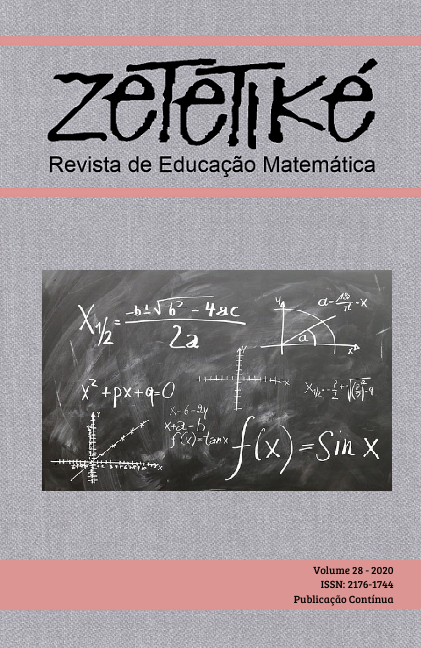Abstract
The research aims to verify if questions oriented to the ninth grade of the Elementary School of the São Paulo State School Performance Assessment System - Saresp, address statistical content using problem solving according to the American document “Guidelines for Assessment and Instruction in Statistical Education - GAISE”. For the selection of the questions, there was a definite time frame, as they are available online in the pedagogical reports from 2008 to 2018. For the presentation and analysis of the questions: we describe the type of reasoning used; we analyze by problem solving and variability from the GAISE document; and finally, we suggest new questions. The results indicate that despite being expressed in Saresp's annual pedagogical reports that problem solving is used in the elaboration of the questions, they were not elaborated considering the theoretical principles of the GAISE document.
References
Chamorro, M. & Vecino, F. (2003). El tratamiento y la resolución de problemas. En Chamorro, M. (Ed.), Didáctica de las Matemáticas para Primaria (pp. 273-299). Madrid: Pearson Educación.
Díaz, V. & Poblete, A. (2001). Contextualizando tipos de problemas matemáticos en el aula. Números: Revista de Didáctica de las Matemáticas, 45, 33-41.
Díaz-Levicoy, D. & Mayorga, A. (2014). La resolución de problemas como herramienta para la integración de contenidos matemáticos. Revista Investigaciones em Educación, 14(1), 25-42.
Fini, M. E. (2018). Leitura crítica: matemática na proposta da BNCC. Disponível em: http://basenacionalcomum.mec.gov.br/images/relatorios-analiticos/Parecer_7_MA_Maria_Eliza_Fini.pdf
Franklin, C. A. & Newborn, D. S. (2006). The Statistical Education of Grades Pre-k-12 Teachers. A shared responsibility. Thinking and Reasoning with Data and Chance, 68th yearbook of the National Council of Teachers of Mathematics.
Franklin, C. A., Kader, G., Mewborn, D., Moreno, J., Peck, R., Perry, M. & Schaeffer, R. (2007). Guidelines for assessment and instruction in statistics education (GAISE) Report: A Pre-K-12 Curriculum Framework. Alexandria, VA. Disponível em: https://www.amstat.org/education/gaise/GAISEPreK-12.htm
Gal, I. (2002). Adult ́s statistical literacy: Meaning, components, responsibilities. International Statistical Review, 70(1), 1-25.
Garfield, J. & Ben-Zvi, D. (2007). How Students Learn Statistics Revisited: A Current Review of Research on Teaching and Learning Statistics, International Statistical Review, 75(3), 372-396.
Groth, R. E. (2006). Engaging Students in Authentic Data Analysis. In G. F. Burril, & P. C. Elliott (Eds.). National Council of Teachers of Mathematics Yearbook.
Herrera, A. (2013). Ambientes de aprendizajes para favorecer el desarrollo del pensamiento y lenguaje matemático: la aventura de pensar en clase de matemática. Revista Ibero-Americana de Estudos Em Educação, 8(4), 1019-1029.
Lammoglia, B. (2013). O Saresp: visão da matemática escolar por atores da rede estadual de ensino. Anais do 11 Encontro Nacional de Educação Matemática. Curitiba (PR): Pontifícia Universidade Católica do Paraná. Retirado em 15 de março, 2020, de: http://sbem.iuri0094.hospedagemdesites.ws/anais/XIENEM/pdf/1940_1382_ID.pdf
Lopes, C. A. E. (2008). O ensino da Estatística e da probabilidade na Educação Básica e a formação dos professores. Caderno Cedes, 28(7), 57-73.
Lopes, C. A. E. (2011). A Estocástica no Currículo de Matemática e a Resolução de Problemas. Anais do 2 Seminário de Resolução de Problema - SERP. Rio Claro (SP): UNESP.
Lopes, C. A. E. (2013). Educação Estatística no curso de licenciatura em Matemática. Bolema, 27(47), 901-915.
Lopes, C. A. E. & Carvalho, C. (2009). Literacia Estatística na Educação Básica. In A. Nacarato, & C. A. E Lopes. Escritas e Leituras na Educação Matemática (pp. 77-92). Belo Horizonte: Autêntica.
Ministério da Educação (MEC). (2017). Base Nacional Comum Curricular: Educação é a base. Ministério da Educação, Brasília, dez. 2017. Disponível em: http://basenacionalcomuma.mec.gov.br/images/BNCC_20dez_site.pdf
Onuchic, L. R. & Allevato, N. S. G. (2005). Novas reflexões sobre o ensino-aprendizagem de matemática através da resolução de problemas. In M. A. V. Bicudo, & M. C. Borba, M. C. (Orgs.), Educação Matemática - pesquisa em movimento (pp. 213-231). São Paulo: Cortez.
Pino, J. & Blanco, L. (2008). Análisis de los problemas de los libros de texto de Matemáticas para alumnos de 12 a 14 años de España y de Chile en relación con los contenidos de proporcionalidad. Publicaciones, 38, 63-88.
Rossman, A., Medina, E. & Chance, B. (2006). A Post-Calculus Introduction to Statistics for Future Secondary Teachers. Proceedings of 7 International Conference on Teaching Statistics (ICOTS). International Statistical Institute, Voorburg, The Netherlands. Retirado em 15 de março, 2020, de: https://iase-web.org/documents/papers/icots7/2E2_ROSS.pdf
Secretaria da Educação do Estado de São Paulo (SEE). (2009). Matrizes de referência para a avaliação Saresp: documento básico/Secretaria da Educação. v. 1. coordenação geral, Maria Inês Fini. – São Paulo: SEE.
Secretaria da Educação do Estado de São Paulo (SEE). (2009a). Relatório Pedagógico: Saresp 2008. Coordenação geral: Maria Inês Fini. São Paulo: SEE.
Secretaria da Educação do Estado de São Paulo (SEE). (2010). Relatório Pedagógico: Saresp 2009. Coordenação geral: Maria Inês Fini. São Paulo: SEE.
Secretaria da Educação do Estado de São Paulo (SEE). (2011). Relatório Pedagógico: Saresp 2010. Execução: Fundação Vunesp. São Paulo: SEE.
Secretaria da Educação do Estado de São Paulo (SEE). (2012). Relatório Pedagógico: Saresp 2011. Execução: Fundação Vunesp. São Paulo: SEE.
Secretaria da Educação do Estado de São Paulo (SEE). (2013). Relatório Pedagógico: Saresp 2012. Execução: Fundação Vunesp. São Paulo: SEE.
Secretaria da Educação do Estado de São Paulo (SEE). (2014). Relatório Pedagógico: Saresp 2013. Execução: Fundação Vunesp. São Paulo: SEE.
Secretaria da Educação do Estado de São Paulo (SEE). (2018). Relatório Pedagógico: Saresp 2018. Execução: Fundação Vunesp. São Paulo: SEE.
Snee, R. (1990). Statistical Thinking and its Contribution to Quality. The American Statistician, 44(2), 116-121.
Wallman, K. K. (1993). Enhancing statistical literacy: Enriching our society. Journal of the American Statistical Association, 88, 1-8.

This work is licensed under a Creative Commons Attribution-NonCommercial-NoDerivatives 4.0 International License.
Copyright (c) 2020 Zetetike


